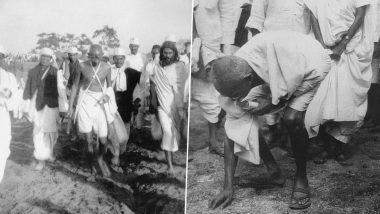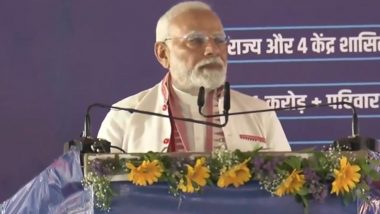Dandi March, also known as the Salt March, Salt Satyagraha, and the Dandi Satyagraha, was an act of nonviolent civil disobedience led by Mahatma Gandhi. The Dandi March began on March 12, 1930 and lasted for 24 days till April 5, 1930. The Salt Satyagraha campaign was based upon Gandhi's principles of non-violent protest called satyagraha. The word satyagraha is formed from the Sanskrit words 'satya' (truth), and 'agraha', (insistence). Mahatma Gandhi chose the 1882 British Salt Act as the first target of satyagraha. Azadi Ka Amrut Mahotsav: Dandi March to Be Re-Enacted in Gujarat, PM Narendra Modi to Flag The Yatra on March 12 from Sabarmati Ashram.
Dandi March or Salt March History
The Indian National Congress chose satyagraha as their main tactic for winning Indian sovereignty and self-rule from British rule in the early 1930s. For this, Mahatma Gandhi was appointed to organise the campaign. The Dandi march spanned 240 miles (390 km), from Sabarmati Ashram to Dandi, which was called Navsari at that time, which is now in Gujarat. Scores of Indians joined them along the way.
When Gandhi broke the British Raj salt laws at 6:30 am on April 6, 1930, it sparked large-scale acts of civil disobedience against the salt laws by millions of Indians. The Dandi March drew worldwide attention to the Indian independence movement through extensive newspaper and newsreel coverage. The salt satyagraha against the salt tax continued for almost a year. It ended with Gandhi's release from jail and negotiations with Viceroy Lord Irwin at the Second Round Table Conference. Although over 60,000 Indians were jailed as a result of the Salt Satyagraha.
Dandi March Significance
The Salt March was a direct action campaign of tax resistance and nonviolent protest against the British salt monopoly. The other reason for Dandi March or Salt March was that the Civil Disobedience Movement needed a strong inauguration that would inspire more people to follow Gandhi's example. Gandhi started this march with 78 of his trusted volunteers. The Salt March was the most significant organized challenge to British authority since the Non-cooperation movement of 1920–22. The Dandi March directly followed the Purna Swaraj declaration of sovereignty and self-rule by the Indian National Congress on January 26, 1930.
The satyagraha teachings of Gandhi and the March to Dandi had a significant influence on American activists Martin Luther King Jr., James Bevel, and others during the Civil Rights Movement for civil rights for African Americans and other minority groups in the 1960s. The Dandi March or the Salt March gave a major fillip to the Indian independence movement and started the nationwide Civil Disobedience The movement continued till 1934.
(The above story first appeared on LatestLY on Mar 11, 2021 04:46 PM IST. For more news and updates on politics, world, sports, entertainment and lifestyle, log on to our website latestly.com).













 Quickly
Quickly





















